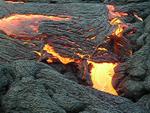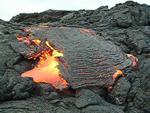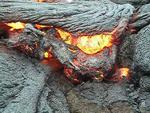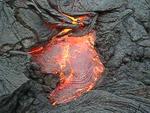|
|
5 July 2003
Breakout mania

|

|
| Left. Small oozing breakout before
dawn from southeast base of tumulus shown in right image. About 150 m
inland from old sea cliff at Highcastle. Width of view, about 1 m. 0538. Right.
Looking west at sunup toward tumulus that fed all lava in images taken
today. Note typical medial crack at top of tumulus. Small breakout in left
image is leftmost incandescent area in image (lower left). All subsequent
images are of breakout that came from area in center of image. 0545. |

|

|
| Left. After 5 minutes of groaning,
scraping, and cracking sounds, area at east base of tumulus above gradually
opened. First lava came from narrow cracks. Then it oozed up already open
cracks. Finally, with a loud tearing sound, a part of the crust gave way
and lava rushed onto surface. This image was taken about 30 seconds after
the breakout started. Stream is 2-3 m long. 0604. Right. View of
source area for breakout to left. Width of moving lava, about 3 m. 0606. |

|

|
| Left. Breakout pours down slope and
cascades over steep pitches, rafting crust along. Crust tears as it plunges
into depression. Width of moving lava, about 3 m. See 0608 video below. 0607:33. Right.
Same area as in left image, but depression is filling and breakout front is
more continuous. Width, about 3 m. 0609:14. |

|

|
| Left. Same area as in right image
above, but 1 minute later and from slightly cooler location. Crust now
coats entire stream into depression, but lava is breaking out from under
crust and continuing its travel downward. Width of entire stream, about 3
m. See 0610 video below. 0610:15. Right. Close up of lava dripping from wrinkled crust
that developed on breakout in left image. Width of view, about 1 m.
0610:47. |

|

|
| Left. Stream shown above has filled
depression and is continuing down broad base of tumulus. Filled depression
is almost exactly in middle of image, along far side of stream. Length of
visible stream, about 5-6 m. 0612. Right. Three minutes later, lava
is continuing to pour from under crust and move downward. Plates of crust
tear from main cover and swirl down steep cascade. Width of moving lava,
about 2 m. 0615. |

|

|
| Left. Ten minutes later, stream has
moved some 8-10 m farther and shows no sign of letting up. Width of stream,
about 1.5-2 m. 0625. Right. Upended slab of crust jammed against
solid crust watches rest of world go by. Slab is 50-60 cm high. 0636. |

|

|
| Left. At snout of still-moving
breakout, lava reaches steep slope and gushes from under crust. Width of
moving lava, about 1 m. 0639:31. Right. Most lava has reached
base of steep pitch and, only 32 seconds later, has developed noticeable
crust that is wrinkling and already breaking. 0640:03. |
6 July 2003
Lava on Pulama pali

|

|
| Left. Predawn view of three surface
lobes of lava on Pulama pali. Near left edge is Kohola arm of Mother's Day
flow. Dead center is west-side lobe of main Mother's Day flow. Just left of center, and most
prominent, are three clusters of surface lava in east-side lobe. Kohola
angles down to left (west); other two angle down to right (east). Near left
edge are two incandescent specks on gentle slope above Paliuli. 0512. Right.
Image from same vantage point but at higher magnification, showing part of
west-side lobe and all of east-side lobe. 0516. |
10 July 2003
Kohola forging new path

|

|
| Left. Channeled lava moves down
moderate slope, flowing across `a`a surface formed slightly earlier.
Channel is 1-2 m wide. Location is just above Paliuli. During 1730-1830
today, lava in this new branch of Kohola dropped over Paliuli. 1055. Right.
Another view of channeled lava on `a`a. 1102. |

|

|
| Left. Visitors admire advancing new
branch of Kohola. Flow eventually moved toward Paliuli and crossed viewing
site. 1106. Right. Incandescent lava in interior of flow with
`a`a crust. 1111. |
12 July 2003
Early morning lava on Pulama pali

|

|
| Compare these two images with those taken
from same place on July 6. Note how far the Kohola has advanced. Left. Predawn view of three surface
lobes of lava on Pulama pali. Near left edge is Kohola arm of Mother's Day
flow. In center is barely visible west-side lobe of main Mother's Day flow.
Near right edge is collection of incandescent areas in east-side lobe.
Distance from Kohola to east-side lobe is about 2 km. 0521. Right.
East-side lobe of main Mother's Day flow. 0525. |

|

|
| Left. Several channels of lava flow
across solidified `a`a at about 400-500-foot elevation between Pulama pali
and Paliuili. Narrow, dark `a`a below channels carried lava across Paliuli
in late afternoon of July 10. 0543. Right. Higher magnification of
channels on steep slope. 0540. |
14 July 2003
Bastille Day at Kohola cascade

|

|
| Left. Cascade down Paliuli in Kohola
arm of Mother's Day flow. This cascade had died by 0600. Height of pali,
12-15 m. 0522. Right. View from top of Paliuli, looking at flow fed
by cascade. Front of flow is at top of image. Note visitors in grassy area
watching the show.0545. |

|

|
| Left. From top of Paliuli, breakout
taking place from crusted flow at foot of pali. Photographer gives scale.
0553. Right. Front of sluggish lobe at base of Paliuli, viewed from
coastal flat. This is remnant of cascade, which died 10-15 minutes earlier.
Incandescent front is about 3 m wide. 0611. |

|

|
| Left. View of sluggish lobe of upper
right image, in context of Paliuli. Note the vegetated pali east of active
flow. The vegetation is in a kipuka about 60-80 m wide, separating a brief
cascade of July 10 from this morning's activity. 0616. Right.
Visitors enjoying show on and just above Paliuli. Note the streams of lava
above Paliuli, one of which fed cascade earlier in morning. 0620. |
21 July 2003
The Kohola works westward

|

|
| Left. Lava flowing down fan developed
in past week on Paliuli. This is new western part of Kohola arm of Mother's
Day flow. Lava fed from this fan--by surface flow and through tubes--has
moved 530 m seaward from base of Paliuli and is still going. 0540. Right.
Photographer urges on a new branch of Kohola arm, coaxing it to bottom of
Paliuli some 150 m west of lava in left image. 0548. |

|

|
| Left. Lava moving toward top of
Paliuli in new branch of Kohola. Highest area is eastward extension of
Holei Pali. 0553. Right. Looking toward dawn, with lava moving down
developing gentle cascade in new branch of Kohola. 0602. |

|

|
| Left. Crack at base of Paliuli
gobbles up lava in new branch of Kohola, completing developing of cascade.
0611. Right. Three tongues of lava pour down lowest part of Paliuli
before filling crack at base and continuing down old ramp to coastal flat
below. 0614. |
22 July 2003
Aerial views of skylight and active flow field

|

|
| Left. Looking up active flow field,
with annotations for several features commonly mentioned in updates
(East-side lobe, Kohola arm, elbow, Paliuli, Holei Pali, and Pu`u `O`o.) Right.
Okita Nuevo skylight, about 1 m in diameter, from air. Note fume rising
from it and from another weak spot in roof of main tube supplying lava to
Mother's Day flow. |
23 July 2003
Lava lazily moves away from Paliuli

|

|
| Left. Front of lazy breakout, with
Paliuli behind. Recent drapery coats Paliuli, but lava in this breakout is
fed by tube in isolated cascade to left of image (see last image today).
0549. Right. Budding lava about 30 cm high almost silently moving
across ground. 0553. |

|

|
| Left. Note gray ash on crust of lava,
left over from burned grass. 0555. Right. Smoke and flame from
small fires along front of slow breakout. 0557. |

|

|
| Left. Shrubbery awaits its fate as
front of breakout nears. 0603. Right. Overview of breakout area,
with photographer and tripod just right of center. Lava flows down Paliuli
through tube from upper right--the area of developing cascade on July 21.
In background is unnamed pali, apparently an eastward continuation of Holei
Pali. 0604. |
27 July 2003
Scenes of lava in western tongue of Kohola

|

|
| Left. Small, amoeboid finger of lava
budding into toes. Largest incandescent toe is about 20 cm across. 0601. Right.
Active flow forms background for loose blocks thrown out by past methane
explosion, possibly during emplacement of nearby older part of Kohola.
Vertical block just left of center is about 40 cm tall. Such large blocks
remind us that some methane explosions can be BIG. 0611. |

|

|
| Left. Smoothly advancing front of
west tongue of Kohola. In background is Paliuli and Pulama pali. Squinting,
you can see surface lava in area of fume above Paliuli. 0614. Right.
Inflating west tongue of Kohola, with small breakouts. Note two clusters of
stones on crust of flow. These clusters were once on the ground surface
before being picked up and uplifted as the flow inflated. The stones are
2-3 cm in diameter. 0616. |

|

|
| These two images were taken from same
location but with different magnifications and look directions. Left.
Breakout about 1 minute after starting from crack in crust of inflating
flow. Tilted slab at right edge of image, just behind moving lava, is
visible at top center of right image. 0619:23. Right. A little more
than 5 minutes later, lava has moved toward camera about 10 m. Note how
crust has formed and become wrinkled as it floats on the advancing lava.
0624:41. |
31 July 2003
Kohola lava on coastal flat

|

|
| Left. Small toe of lava developing
wrinkled crust in western finger of Kohola arm. Toe is about 50 cm wide.
0517. Right. Lava debouching from front of inflating flow and
burning grass. Note wrinkled crust formed where lava slows on gentle slope.
Toe is about 40 cm wide. 0526. |

|

|
| Left. Tracks of flying embers (left
center) reach downwind from burning grass along edge of active breakout.
The golden tracks, ephemeral though they may be, are remindful of coarse
Pele's hair. 0529. Right. Stream of lava issues from inflating
flow, burning grass and creating embers whose tracks look like scratches on
film. Stream is about 3 m long. 0541. |

|

|
| Left. Front of stream in right image
above, sluggish and nearly stagnant. Note deeply corrugated crust Width of
view, about 3 m. 0543. Right. Edge of moderately large breakout
moving down gentle slope as series of interconnected toes. Active breakout
is 20-30 cm thick. 0550. |
5 July 2003

|
July 5, 2003; 0608. Lava pours out from under
crust at front of advancing breakout. See still
taken at 0607:33 today.
|

|
July 5, 2003; 0610. Lava emerges from under crust
along side of breakout on steep slope. Listen to creaking sounds, about
halfway through video, as crust
flexes and breaks. See still
taken at 0610:15 today.
|

|
July 5, 2003; 0619. Lava appears from under crust
and drops into depression at front of advancing breakout. Width of blob of
lava that appears is about 30 cm.
|

|
July 5, 2003; 0622. This clip lasts 30 seconds
and so is a large file, but it shows such notable dynamics at flow front that it might be worth it to some of you patient ones.
The active stream is 50-75 cm wide. Note, early on, how sliding crust plows
into lava.
|
Map of flows from Pu`u `O`o: 16 May 2003

Map shows lava flows erupted during 1983-present activity of Pu`u `O`o
and Kupaianaha (see
large map). Red colors, both dark and light, denote Mother's Day flow, which
began erupting on May 12, 2002 and continues to the present. The darkest color
represents flows active since January 21, 2003.
Most recent--and ongoing--activity has produced two flows, one along western
edge of flow field and one slightly farther east. Kohola flow, along western
margin, entered sea late on Valentine's Day to form short-lived Kohola ocean
entry. This flow shortened the road still more. Visitors now can drive to Holei Sea Arch, 1.1 km from Kohola flow, and walk
to see flow. Breakouts have been visible in various parts of Kohola flow,
shifting from time to time across width and length of flow.
Other dark red flow is main active part of Mother's Day flow. Fed by
breakouts from lava tube in main Mother's Day flow, it advanced along eastern
margin of main flow and down Pulama pali and Paliuli. Western of two forks below
Paliuli dripped over sea cliff at Highcastle on May 19, 2003, after map was
made.
Lava from earlier, pre-January 21, 2003 Mother's Day flow (light red) reached sea at West Highcastle early on July 19, at Wilipe`a early on
July 21, and at Highcastle on August 8. From near southwest base of Pu`u `O`o, Mother's Day flow passes along west side of flow field and into forest, where it started large wildfire in May that continued into late July. By June 10,
Mother's Day flow had reached base
of Paliuli, the steep slope and cliff below Pulama pali and just above coastal flat. At base of Paliuli, Mother's Day flow abruptly spread
laterally in series of small budding flows to cover an area nearly 2 km
wide, gradually moving seaward until West Highcastle and Wilipe`a lobes
finally reached water and started building lava deltas. Activity at West
Highcastle ended in early August, but entry began soon thereafter at Highcastle,
eventually burying tiny kipuka of Chain of Craters Road. Wilipe`a entry
died away slowly and had ended by mid-August. Highcastle and neighboring
Highcastle Stairs entries ended on about August 23. For a time there were no
active entries. Then Wilipe`a was reactivated on September 3 but stopped in
December. West Highcastle likewise renewed activity on September
16-17, died away during night of September 18-19, and returned soon
thereafter to continue through March 21. East arm of Mother's Day flow
branched from Highcastle lobe in late October and sent three fingers into ocean
at Highcastle on November 15, West Lae`apuki on November 19, and Lae`apuki on
November 20. Lae`apuki entries had stopped by November 29. If this sounds
like soap opera, the truth is even more confusing than the simplified version
of activity given here.
The URL of this page is
http://hvo.wr.usgs.gov/kilauea/update/archive/2003/Jul/
Contact:
hvowebmaster@usgs.gov
Updated: 3 August 2003 (DAS)
|





























































